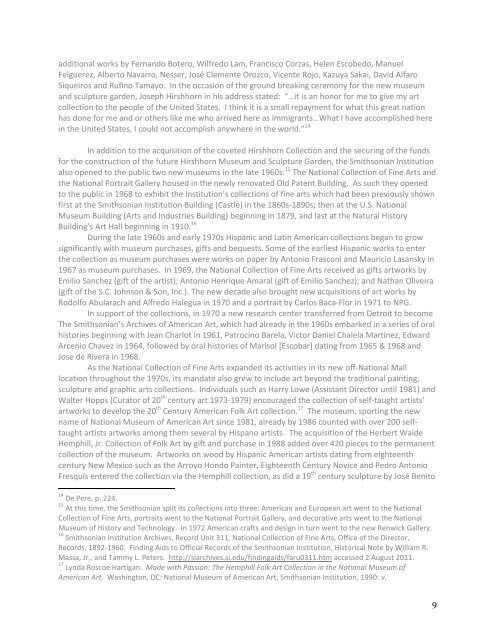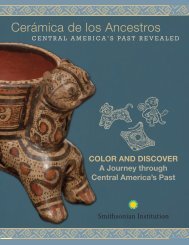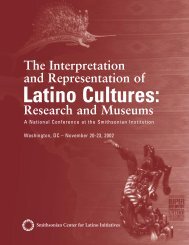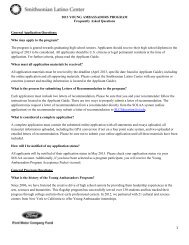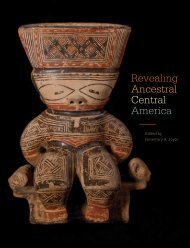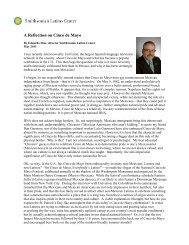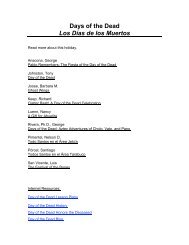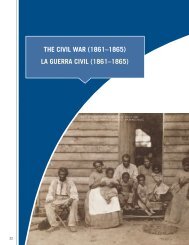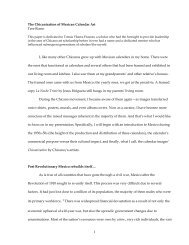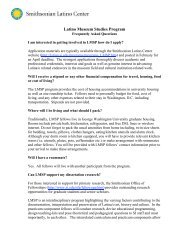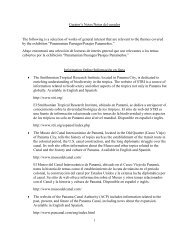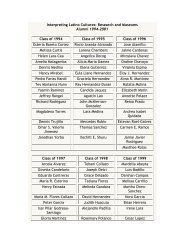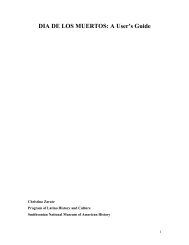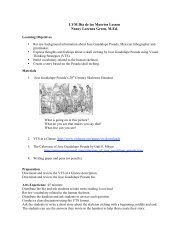smithsonian latino art collections - Smithsonian Latino Center
smithsonian latino art collections - Smithsonian Latino Center
smithsonian latino art collections - Smithsonian Latino Center
Create successful ePaper yourself
Turn your PDF publications into a flip-book with our unique Google optimized e-Paper software.
additional works by Fernando Botero, Wilfredo Lam, Francisco Corzas, Helen Escobedo, Manuel<br />
Felguerez, Alberto Navarro, Nesser, José Clemente Orozco, Vicente Rojo, Kazuya Sakai, David Alfaro<br />
Siqueiros and Rufino Tamayo. In the occasion of the ground breaking ceremony for the new museum<br />
and sculpture garden, Joseph Hirshhorn in his address stated: “…it is an honor for me to give my <strong>art</strong><br />
collection to the people of the United States. I think it is a small repayment for what this great nation<br />
has done for me and or others like me who arrived here as immigrants…What I have accomplished here<br />
in the United States, I could not accomplish anywhere in the world.” 14<br />
In addition to the acquisition of the coveted Hirshhorn Collection and the securing of the funds<br />
for the construction of the future Hirshhorn Museum and Sculpture Garden, the <strong>Smithsonian</strong> Institution<br />
also opened to the public two new museums in the late 1960s: 15 The National Collection of Fine Arts and<br />
the National Portrait Gallery housed in the newly renovated Old Patent Building. As such they opened<br />
to the public in 1968 to exhibit the Institution’s <strong>collections</strong> of fine <strong>art</strong>s which had been previously shown<br />
first at the <strong>Smithsonian</strong> Institution Building (Castle) in the 1860s-1890s; then at the U.S. National<br />
Museum Building (Arts and Industries Building) beginning in 1879, and last at the Natural History<br />
Building’s Art Hall beginning in 1910. 16<br />
During the late 1960s and early 1970s Hispanic and Latin American <strong>collections</strong> began to grow<br />
significantly with museum purchases, gifts and bequests. Some of the earliest Hispanic works to enter<br />
the collection as museum purchases were works on paper by Antonio Frasconi and Mauricio Lasansky in<br />
1967 as museum purchases. In 1969, the National Collection of Fine Arts received as gifts <strong>art</strong>works by<br />
Emilio Sanchez (gift of the <strong>art</strong>ist); Antonio Henrique Amaral (gift of Emilio Sanchez); and Nathan Oliveira<br />
(gift of the S.C. Johnson & Son, Inc.). The new decade also brought new acquisitions of <strong>art</strong> works by<br />
Rodolfo Abularach and Alfredo Halegua in 1970 and a portrait by Carlos Baca-Flor in 1971 to NPG.<br />
In support of the <strong>collections</strong>, in 1970 a new research center transferred from Detroit to become<br />
The <strong>Smithsonian</strong>’s Archives of American Art, which had already in the 1960s embarked in a series of oral<br />
histories beginning with Jean Charlot in 1961, Patrocino Barela, Victor Daniel Chalela M<strong>art</strong>inez, Edward<br />
Arcenio Chavez in 1964, followed by oral histories of Marisol [Escobar] dating from 1965 & 1968 and<br />
Jose de Rivera in 1968.<br />
As the National Collection of Fine Arts expanded its activities in its new off-National Mall<br />
location throughout the 1970s, its mandate also grew to include <strong>art</strong> beyond the traditional painting,<br />
sculpture and graphic <strong>art</strong>s <strong>collections</strong>. Individuals such as Harry Lowe (Assistant Director until 1981) and<br />
Walter Hopps (Curator of 20 th century <strong>art</strong> 1973-1979) encouraged the collection of self-taught <strong>art</strong>ists’<br />
<strong>art</strong>works to develop the 20 th Century American Folk Art collection. 17 The museum, sporting the new<br />
name of National Museum of American Art since 1981, already by 1986 counted with over 200 selftaught<br />
<strong>art</strong>ists <strong>art</strong>works among them several by Hispano <strong>art</strong>ists. The acquisition of the Herbert Waide<br />
Hemphill, Jr. Collection of Folk Art by gift and purchase in 1988 added over 420 pieces to the permanent<br />
collection of the museum. Artworks on wood by Hispanic American <strong>art</strong>ists dating from eighteenth<br />
century New Mexico such as the Arroyo Hondo Painter, Eighteenth Century Novice and Pedro Antonio<br />
Fresquís entered the collection via the Hemphill collection, as did a 19 th century sculpture by José Benito<br />
14 De Pere, p. 224.<br />
15 At this time, the <strong>Smithsonian</strong> split its <strong>collections</strong> into three: American and European <strong>art</strong> went to the National<br />
Collection of Fine Arts, portraits went to the National Portrait Gallery, and decorative <strong>art</strong>s went to the National<br />
Museum of History and Technology. In 1972 American crafts and design in turn went to the new Renwick Gallery.<br />
16 <strong>Smithsonian</strong> Institution Archives, Record Unit 311, National Collection of Fine Arts, Office of the Director,<br />
Records, 1892-1960. Finding Aids to Official Records of the <strong>Smithsonian</strong> Institution, Historical Note by William R.<br />
Massa, Jr., and Tammy L. Peters. http://siarchives.si.edu/findingaids/faru0311.htm accessed 2 August 2011.<br />
17 Lynda Roscoe H<strong>art</strong>igan. Made with Passion: The Hemphill Folk Art Collection in the National Museum of<br />
American Art. Washington, DC: National Museum of American Art, <strong>Smithsonian</strong> Institution, 1990: v.<br />
9


